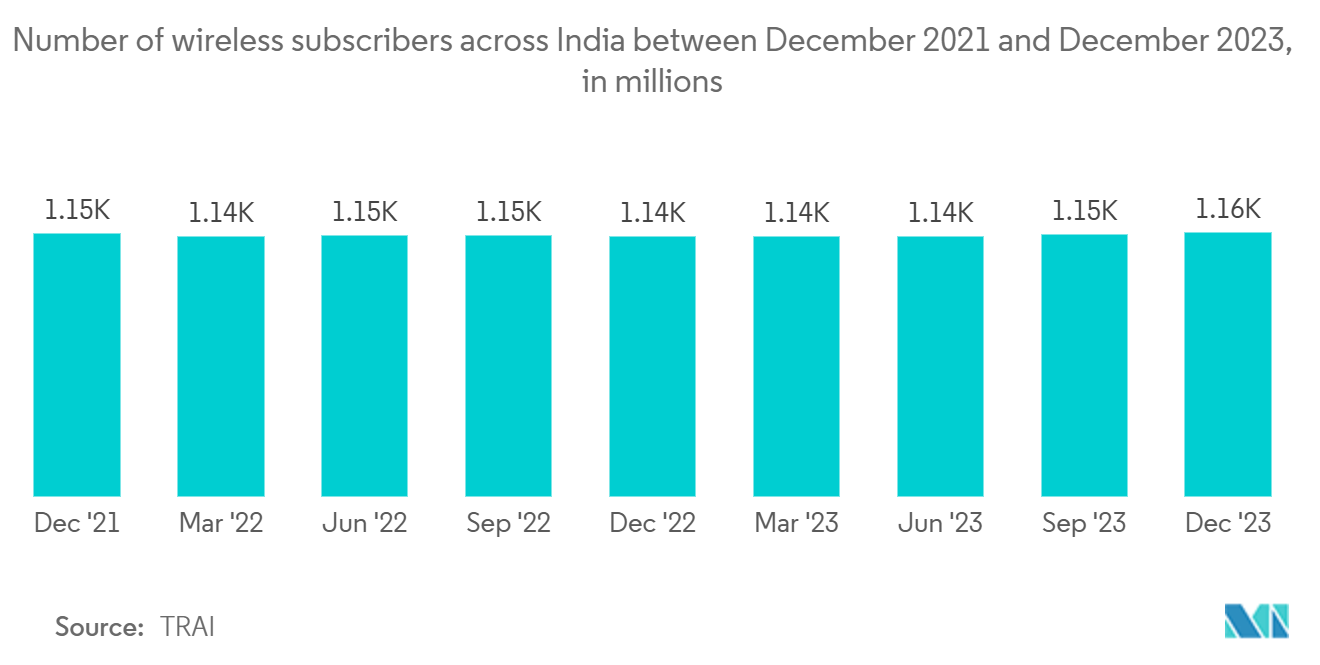Market Trends of India Telecom Industry
Wireless Voice Services are Gaining Significant Momentum in the Market
- Affordable rates, expanding 3G and 4G coverage, and the advent of 5G shifting customer consumption patterns have significantly contributed to the industry's exponential expansion in recent years. For instance, in May 2024, Vodafone Idea (Vi) made a strategic move, unveiling its 'Vi Guarantee Program,' a limited-time recharge plan. This initiative, widely considered a precursor to its impending 5G launch, is tailored for 4G and 5G smartphone users. As reported by Business Standard, the plan promises an additional 130 GB of data over a year. Vi subscribers will receive 10 GB of this bonus data every 28 days for 13 cycles.
- In recent years, according to a PIB report, India has significantly narrowed the gap between its imports and exports, with a notable shift toward fulfilling most of its 5G demands through domestic production. Notably, Indian telecom companies exported telecom equipment and accessories worth INR 25,200 crore last year.
- The Department of Telecommunications (DoT) has been actively promoting Indian products on the global stage, facilitating these exports. Key players like Tejas Networks, Lekha Wireless, and VVDN, benefiting from the Production Linked Incentive (PLI) scheme, alongside Astrome, WiSig, and Signalchip, beneficiaries of the Domestic Companies Incentive Scheme (DCIS), were pivotal members of multiple MWC delegations.
- Their participation led to new deals and marked a significant entry into the Western markets, especially the United States. For instance, Astrome is spearheading the export of its E Band technology for a USD 50 billion Rural Backhaul program. WiSig's ORAN network is currently being tested at Virginia University. VVDN, with offices now established in three US locations, Vermont, Austin, and New York, has already secured prominent clients like CISCO, Mavenir, and TESLA. Additionally, 31 startups, part of the MWC delegations in the United States and Spain, collectively generated business leads worth approximately USD 100 million. All these numbers represent the flourishing nature of the telecom industry in India.

Growth of Data and Messaging Services
- In India, the demand for data and messaging services has been rising with an increase in telecom tower services across the country. India's proactive stance at the World Radio Conference secured spectrum exclusivity for its operations in airspace and sea, shielding them from IMT operations of other nations and paving the way for future 5G rollouts. In a significant move, the Telecom Secretary was appointed as co-chair of the ITU Digital Innovation Board in March 2024, bolstering India's influence in shaping global digital innovation. India recognizes the pivotal role of collaborations with partner nations and international bodies like ITU and APT in its telecom growth. Such partnerships offer access to advanced technology and patents to amplify India's contributions to bodies like ITU and bolster its SEPs.
- Under the Bharat 6G Alliance, India is forging a Memorandum of Understanding with the NextG Alliance of ATIS, United States, and the 6G Smart Networks and Services Industry Association (6G-IA) of the European Union. This collaboration aims to delve into 6G wireless technologies, foster a unified 6G vision, and fortify telecommunications with secure supply chains.
- India is set to host the World Telecommunication Standardization Assembly (WTSA) for the first time in October 2024. The event, expected to draw over 2000 delegates from 180 nations, will chart the course for the next generation of telecommunication standards.
- Smartphones are a major source of data consumption and messaging services in India. According to the GSMA, India is on the path to becoming a significant smartphone market by 2025, with approximately 1 billion devices installed. It is predicted to have 920 million unique mobile customers by 2025, including 88 million 5G connections. 5G technology is expected to add USD 450 billion to the Indian economy between 2023 and 2040.
- The government focuses on increasing broadband network services, which will increase the use of data. For instance, in February 2023, The Ministry of Communications, in a gazette notification published on February 1, announced the revision of the definition of broadband, which supersedes the previous one issued in 2013, which was made after the consideration of the TRAI. As per the new definition, "Broadband is a data connection that can support interactive services, including internet access, and has the capability of a minimum download speed of 2 Mbps to an individual subscriber from the point of presence (POP) of the service provider intending to provide broadband service."
- Furthermore, among the primary factors that lead to the segment's rise are the use of more than one device per user, high rates of replacement, and people transitioning from traditional phones to smartphones as prices drop.



